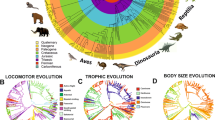Abstract
THE slender elongated form that is characteristic of the forelimb long bones of gibbons (Hylobates) has long been attributed to their functional adaptation to habitual armswinging locomotion1–3, although potential selective advantages of this morphology for brachiation have yet to be demonstrated. If the forces exerted on the limb skeleton during brachiation indeed differ greatly from those of other locomotor modes, then the changes in skeletal loading accompanying a shift in locomotor behaviour could favour alterations in skeletal morphology in brachiating lineages. In vivo skeletal strain patterns recorded by using radiotelemetry during brachiation indicate that the forelimb bones of the gibbon are loaded in substantial tension and show reduced bending and compression in comparison with those of other mammals. We suggest that this unique loading regime could have contributed to the evolution of the distinctive morphology of hylobatid limbs.
This is a preview of subscription content, access via your institution
Access options
Subscribe to this journal
Receive 51 print issues and online access
$199.00 per year
only $3.90 per issue
Buy this article
- Purchase on Springer Link
- Instant access to full article PDF
Prices may be subject to local taxes which are calculated during checkout
Similar content being viewed by others
References
Keith, A. J. Anat. 37, 18–40 (1903).
Andrews, P. & Groves, C. E. in Gibbon and Siamang (ed. Rumbaugh, D. M.) 167–218 (Karger, Basel, 1976).
Preuschoft, H. & Demes, B. in Size and Scaling in Primate Biology (ed. Jungers, W. L.) 383–399 (Plenum, New York, 1985).
Fleagle, J. G. Nature 248, 259–260 (1974).
Preuschoft, H. & Demes, B. in The Lesser Apes: Evolutionary and Behavioral Biology (eds Preuschoft, H., Chivers, D. J., Brockelman, W. V. & Creel, N.) (Edinburgh University Press, 1984).
Kummer, B. Anthrop. Anz. 32, 74–82 (1970).
Oxnard, C. E. The Order of Man (Yale University Press, New Haven, 1984).
Currey, J. D. The Mechanical Adaptations of Bones (Princeton University Press, New Jersey, 1984).
Biewener, A. A., Thomason, J., Goodship, A. E. & Lanyon, L. E. J. Biomech. 16, 565–576 (1983).
Lanyon, L. E. & Bourne, S. J. Bone Jt Surg. A61, 263–273 (1979).
Biewener, A. A., Swartz, S. M. & Bertram, J. E. A. Calcif. Tissue Int. 39, 390–395 (1986).
Biewener, A. A. & Taylor, C. R. J. exp. Biol. 123, 383–400 (1986).
Wainwright, S. A., Biggs, W. D., Currey, J. D. & Gosline, J. M. Mechanical Design in Organisms (Wiley, New York, 1976).
Swartz, S. M. The Biomechanics and Structural Design of the Forelimb of Brachiating Primates (The University of Chicago Press, 1988).
Dally, J. W. & Riley, W. F. Experimental Stress Analysis (McGraw-Hill, 1978).
Rubin, C. T. & Lanyon, L. E. J. exp. Biol. 101, 187–212 (1982).
Bertram, J. E. A. & Biewener, A. A. J. theor. Biol. 131, 75–92 (1988).
Jungers, W. L. & Stern, J. T. Jr Science 208, 617–619 (1980).
Jungers, W. L. & Stern, J. T. Jr Int. J. Primat. 2, 18–33 (1981).
Jungers, W. L. & Stern, J, T. Jr in The Lesser Apes: Evolutionary and Behavioral Biology (eds Preuschoft, H., Chivers, D. J., Brockelman, W. V. & Creel, N.) 119–134 (Edinburgh University Press, 1984).
Avis, V. Southw. J. Anthrop. 18, 119–148 (1962).
Jenkins, F. A. Jr, Bombroski, P. J. & Gordon, E. P. Am. J. phys. Anthrop. 48, 65–76 (1978).
Jenkins, F. A. Jr Symp. zool. Soc. Lond. 48, 429–451 (1981).
Lanyon, L. E. & Baggot, D. G. J. Bone Jt Surg. B58, 436–443 (1976).
Author information
Authors and Affiliations
Rights and permissions
About this article
Cite this article
Swartz, S., Bertram, J. & Biewener, A. Telemetered in vivo strain analysis of locomotor mechanics of brachiating gibbons. Nature 342, 270–272 (1989). https://doi.org/10.1038/342270a0
Received:
Accepted:
Issue Date:
DOI: https://doi.org/10.1038/342270a0
This article is cited by
-
Ulna Curvature in Arboreal and Terrestrial Primates
Journal of Mammalian Evolution (2021)
-
Gibbon-inspired Robust Asymmetric Brachiation along an Upward Slope
International Journal of Control, Automation and Systems (2019)
Comments
By submitting a comment you agree to abide by our Terms and Community Guidelines. If you find something abusive or that does not comply with our terms or guidelines please flag it as inappropriate.



